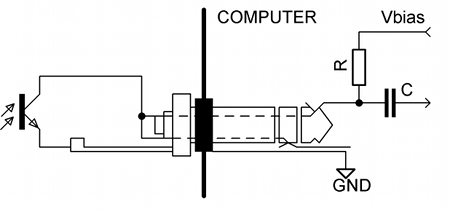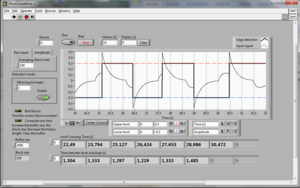EFFICIENT SOUND CARD BASED EXPERIMENTION AT DIFFERENT LEVELS OF NATURAL SCIENCE EDUCATION paper tells that sound cards can be turned into measurement tools, making science experimentation very efficient and cheap. Sound-card experimentation becomes really viable only if we demonstrate how to connect different sensors to the sound card and provide suitable open-source software to support the experiments. This paper present a few applications of sound cards in measurements: photogates, stopwatches and temperature measurement. The writers also provide the software for these applications.
Here is one good example circuit idea from the paper:
Phototransistors and photoresistors can be directly connected to the microphone input. The photodetector and the sound card’s internal resistor R and Vbias voltage forms a light-controlled voltage divider, therefore a voltage pulse can be measured, if the light beam is blocked from the detector. The soundcard mic input capacitor C blocks all the DC component from the input signal, but all signal changes can be easily detected from the recorded sound signal.
Sub-$10 sound card photogate variants page gives some ideas how you can easily build your own photogates.


9 Comments
estimates atmospheric says:
As a web site op I think the material right here is reallymagnificent. I enjoy it for the efforts. You must maintain it up forever! Wish of luck.
removal of skin tags says:
Fantastic your post – A single point to consider is always not everybody is heading to like or accept us in existence even though we like them.
Sylvia says:
I don’t really know much about soundcard and this is really helpful. Thanks for imparting us which can be the best to used. I will try to look out for this.
Sylvia
Kindly visit my website, please cliquez ici.
adult tutus says:
Almost all of the things you assert happens to be astonishingly legitimate and that makes me wonder the reason why I had not looked at this with this light previously. Your article really did turn the light on for me as far as this particular issue goes.
Tomi Engdahl says:
Measure resistance and temperature with a sound card
http://www.edn.com/design/consumer/4368082/Measure-resistance-and-temperature-with-a-sound-card
Tomi Engdahl says:
Sound Card Tachometer Rises From the Junkbox
http://hackaday.com/2014/02/25/sound-card-tachometer-rises-from-the-junkbox/
An IR break beam sensor from an old printer was a perfect fit in an aluminum tube.
Measuring the RPM of the device under test is simply a matter of determining the frequency of the signal and multiplying by 60. A 400 Hz signal would correspond to a shaft turning at 24,000 RPM.
This is due to the AC coupled nature of sound cards. As the signal approaches DC, the waveform will become more distorted.
carolina says:
Hello,
Thanks for this article which I think will be helpful for me.
Tomi Engdahl says:
https://hackaday.com/2021/07/03/your-pc-sound-card-as-a-sensor-input/
https://nagimov.me/post/measure-with-music-how-to-read-analog-sensors-using-a-pc-sound-card/
Tomi Engdahl says:
https://www.onetransistor.eu/2019/11/audio-card-infrared-receiver.html